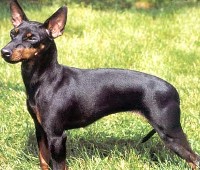Tuesday, March 6, 2007
A toy dog is a very small dog kept as a pet, as compared to a very small working dog, although both pet and working dogs can be very small. When an all-breed association or kennel club divides dog breeds into groups for purposes of competition, the Toy Group contains most of the smallest dog breeds in the club's registry. There has been much discussion as to whether the designation signifies only a dog's size (weight, height, or both), or also refers to how a breed is used or its temperament. This has sometimes led to misunderstanding or bad feeling in the world of purebred dogs; there seems to be no consensus.
It seems safest to define toy dogs as being determined by the size of the dogs, and leave discussion of function and temperament to the various breed clubs. However, this can also be problematic, as there is no firm agreement on what height or weight makes a dog a toy, and the upper height limit of some toy dog breeds is over 12 inches at the withers, which places these dogs within the height range of dogs in some other groups as well.
The use of the word "toy" to describe small dogs that belong to a toy breed is redundant and also incorrect, suggesting that the breed comes in different sizes—there is no such thing, for example, as a "toy Chihuahua"; all Chihuahuas are toy dogs. (However, some breeds do come in different sizes, such as Poodles, which come in standard, miniature, and toy varieties).
Toy dogs refers to size, pictures documenting the history of size are often referred to by breeders. The small size and sweet expressions of these dogs illustrate the main function of this group: to delight the owner. Many Toys are very tough; don�t let their size fool you. Toys have always been popular with people that live in cities and apartments. Toy dogs refers to size, pictures documenting the history of size are often referred to by breeders.
LIST OF TOY BREEDS
- Affenpinscher
- Australian Silky Terrier
- Bichon Frisé
- Biewer
- Bolognese
- Boston Terrier
- Brussels Griffon
- Cavachon
- Cavalier King Charles Spaniel
- King Charles Spaniel or English Toy Spaniel
- Chihuahua
- Chinese Crested Dog
- Cockapoo
- English Toy Terrier
- Havanese
- Italian Greyhound
- Japanese Chin
- Maltese
- Toy Manchester Terrier
- Toy Mi-Ki
- Miniature Pinscher
- Miniature Dachshund
- Papillon
- Pekingese
- Phalène
- Pomeranian
- Pug
- Shih Tzu
- Spoodle
- Tibetan Spaniel
- Toy American Eskimo
- Toy Fox Terrier
- Toy Poodle
- Yorkshire Terrier
- Russian toy terrier
What makes a toy breed
Size
Inconsistency in the placement of small terriers into various kennel club's groups illustrates the point. The Tenterfield Terrier, for example, is in Group 2, Terriers of the Australian National Kennel Council (ANKC). It was slated for placement in Group 1, Toys, but quickly reclassified after objection from owners, who argued that the Tenterfield was a working terrier. In the American Kennel Club (AKC), the Toy Fox Terrier, a dog of similar type to the Tenterfield, was placed in the Toy Group without objection from owners, but is in the Terrier Group in the United Kennel Club (UKC). The diminutive Yorkshire Terrier is undisputedly a toy. The Australian Terrier is one of the smallest terriers, but is in the Terrier group.
Form versus function
Another area of contention is the idea that toy dogs are only companion animals, slow moving, with little need for exercise and with low endurance. Papillons give lie to this; although dainty and small they are quite capable of taking long walks with their humans and often excel at the energetic sport of dog agility. Maltese are another example of very robust daintiness. The UKC defines Italian Greyhounds as having been bred exclusively as pets; the AKC states that these dogs were bred as gazehounds, dogs that hunt by sight, and are quite fast and hardy, but they are nevertheless members of the AKC Toy group.
Tea cup dogs (AKA tiny dogs)
The terms "teacup" or ("tea cup") and "tiny toy," have increasingly come to be used to describe adult dogs that are very small. The terms, however, are not used officially by any kennel club, and their use remains inaccurate and controversial. Since the terms are unofficial, there is no accepted standard of definition for the terms; thus, an eight-pound chihuahua (much larger than the maximum defined in the breed standard) can be described as a "teacup." The increasing frequency of use of the terms by laypersons has led some to believe that the terms are official, however, this has never been the case (see Chihuahua).
Most who are involved in dog breeding and judging argue that the whole concept of the "teacup" is nothing more than a marketing ploy to charge exorbitant prices for dogs that are frequently runts or that may have health problems due to dwarfing. Dogs that are exceedingly small, particularly those that are two pounds or less fully grown, often have shortened life spans and require special care.
Yet, beyond opinions and controversy, "teacup" is a term aiming at describing, and widely understood to mean "smaller than toy dogs". These are sometimes also referred to as "tiny" dogs.


























0 comments:
Post a Comment